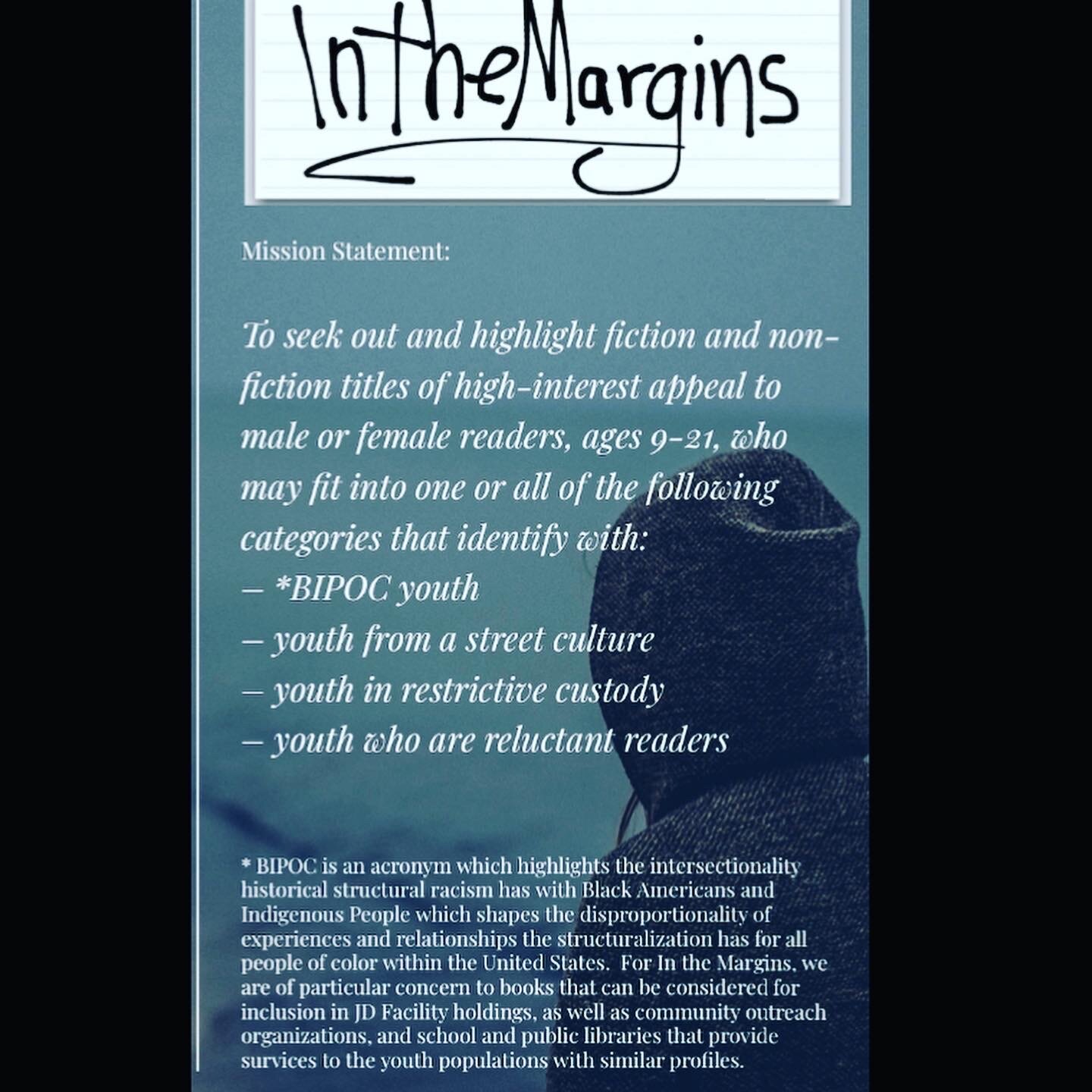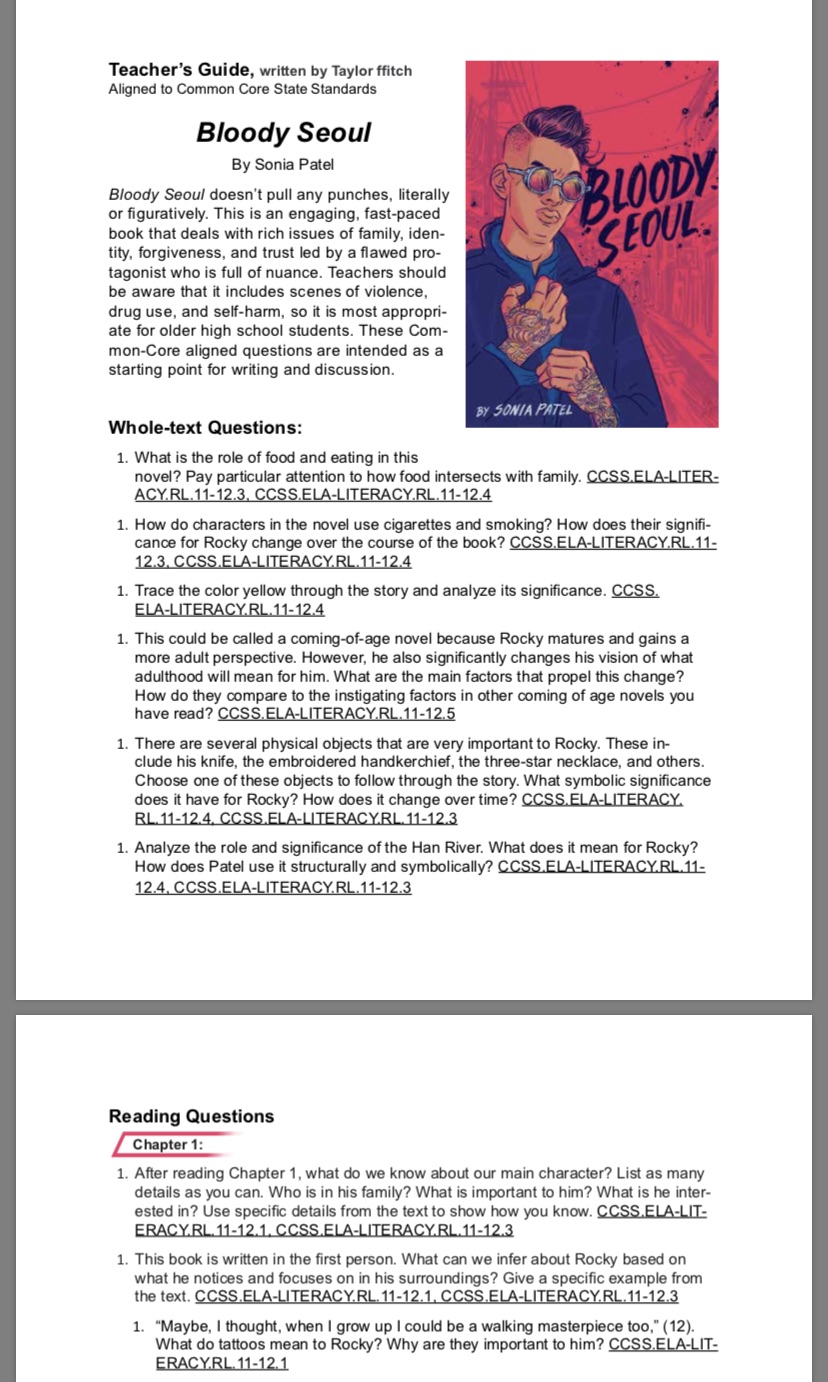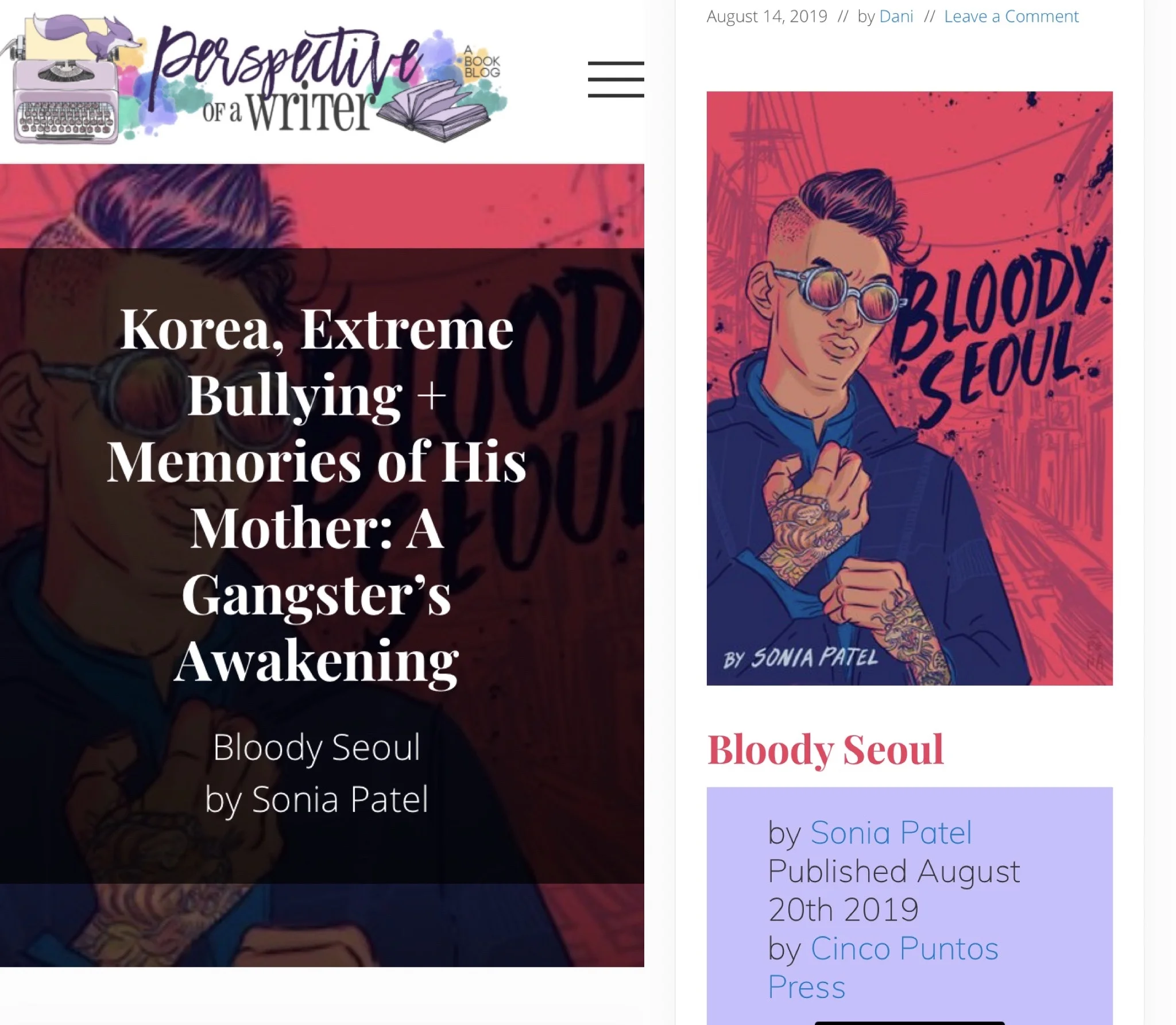bloody seoul
FORTUNATE TO BE PART OF THIS GREAT PODCAST FROM CINCO PUNTOS PRESS!
“From the El Paso-based indie publisher, Cinco Puntos Press. Writers talk with each other about their books. This episodes features Sonia Patel, author of BLOODY SEOUL, chatting with Jacqueline Briggs Martin and June Jo Lee, co-authors of CHEF ROY CHOI AND THE STREET FOOD REMIX from Readers To Eaters. They had a wonderful conversation about the connection and comfort food can bring us, the concept of sohn maash in Korean culture, why we should make the world bigger instead of trying to fit in, and many more great things!”
Check out the BLOODY SEOUL Teacher’s Guide (Aligned to Common Core State Standards)!
Giddy in all the good feels from this BLOODY SEOUL review in CLEAVER LITERARY MAGAZINE
I appreciate this review by a strong advocate of diverse children’s books…
BLOODY SEOUL
by Sonia Patel
Cinco Puntos Press, 276 Pages
reviewed by Kristie Gadson
To Rocky, the city of Seoul is truly something to behold. Sprawling skyscrapers dare to kiss the sky, thousands of lights rival the sun at night, and millions of people bustle through at any given moment, while the Han River remains a calm force through it all. And it will soon be his to rule, just like his father, the leader of the city’s most notorious gang, Three Star Pa.
However, despite Rocky being the sole heir and next in line to become the big boss, his father refuses to turn the gang over to him. Frustrated, Rocky isn’t entirely surprised. It’s one of too many unanswered questions that plague him, especially since his mother’s faded memory threatens to slice the edges of his own mind like a knife.
Aim. Throw.
Sixteen times, one for every year of my life.
Aim. Throw.
Ten times, one for every year mom’s been gone.
Aim. Throw.
Ten times, one for every year Dad’s been the most pissed off person I’ve ever known.
In Sonia Patel’s poetic, fast-paced and electrifying second novel Bloody Seoul, the thread of Rocky’s past unravels the life he has carefully planned. Molding his life to mirror his father’s, he leads his own Three Star Pa gang made up of his closest friends. He beats up his weaker classmates, fist fights to defend his turf against rival gangs, and torments Ha-Na, a mixed Korean and Indian girl whom he regards as an easy target. Rocky’s life is structured to form the future he desires; but his mind frequently dives into the pool of reverie, where the ghost of his missing mother beckons and the needles of his fractured family sting.
What makes Rocky’s story so tangible is how Patel invokes memory and stitches it throughout the first-person narrative. Rocky’s past comes forth by means of his senses: he sees a family photo and remembers a time when his father was happy, he feels his mother’s love within the careful stitch work of the handkerchief he keeps, and smells her scent when he smokes her favorite brand of cigarettes. He also hears her humming when he plays his favorite songs and feels the presence of his uncles when he eats their favorite dishes. Memory is naturally triggered by the five senses, and Patel uses these to further develop Rocky’s character and have us connect with him.
The memories of his past reveal many open wounds, forcing Rocky to confront his father about what really happened to his uncles, his mother, and their family. But his father answers Rocky’s questions with threats and bruises, a direct violation of the first code of Three Star Pa: Family comes first. Family is to be protected at all costs. His father’s blatant disregard of that code forces Rocky to realize his father’s true nature and the lengths his father will go to get what he wants.
There are many ways I’m like my dad, many ways I want to be like my dad, but killing people isn’t one of them.
Patel’s writing shines. Her words flow across the page like a poem – descriptive yet succinct, observant of an entire world in so few phrases. Her writing style reflects Rocky’s character. It is observant, wastes no time equivocating, and takes everything in while focusing on what’s most important with sharp precision. The language may seem shallow at first – like Rocky’s perception of his own life and goals – but the more Rocky plunges into his memories, the deeper the language pulls readers in.
Patel explores how the interconnectivity of memory and family shapes one’s identity. Rocky’s identity is hugely shaped by his relation to his father and Three Star Pa, which had always remained unchallenged. Memories of his past and, most importantly, of his mother undermine this identity, causing it to crack and break. His journey toward redefining himself is a difficult one that readers can relate to. Who are we if not an extension of our family? When memories of a difficult past cause us to break away from our families, how do we go about defining ourselves without them? And who do we let in to our chosen family?
To these questions, Rocky learns there is no easy answer. Discovering who we are is simply that: discovery. And there is no end to it. It’s a journey with no set destination, and in the face of hardship all we can do – all we must do – is keep moving forward. Bloody Seoul teaches us this lesson through colorful and subtly powerful storytelling, gripping readers from beginning to end. A one-of-a-kind read.
New life just around the bend.
More happiness than I can comprehend.
◊◊
Kristie Gadson is a recent graduate of the University of Pennsylvania with a Bachelor’s in English. But, formalities aside, she knew that children’s books would become her passion when she found herself sneaking into the children’s section of Barnes & Noble well after she turned eighteen. She is a strong advocate for diverse children’s books, and writes diverse children’s book reviews on her blog The Black Sheep Book Review.
I love this blogger's post on BLOODY SEOUL: Korea, Extreme Bullying + Memories of His Mother: A Gangster’s Awakening
CHILDREN'S BOOK COUNCIL DIVERSITY NEWSLETTER, JULY 2019- I'M GRATEFUL FOR THIS INTERVIEW!
SAFE DIVERSITY IN YA LIT ISN’T ENOUGH DIVERSITY
While YA novels are increasingly diverse, safe diversity—with accessible and likable protagonists and their convenient struggles—is usually seen as enough. These unoffending books tend to be championed and more popular. Unsettling diversity, on the other hand, is often frowned upon, discounted, or misconceived.
I’m a practicing child and adolescent psychiatrist and a young adult novelist. To me, dismissing YA that’s outside the realm of palatable diversity is like a psychiatrist refusing to treat certain teen patients because they have “too many problems.”
I’ve spent over fifteen years treating diverse teens who suffer tremendous adversity—abuse of all kinds, neglect, parental mental illness or drug use, etc. Medical research proves that youth exposed to these types of adverse experiences have an increased incidence of chronic medical and mental health problems, increased risky behaviors, and less future success. That’s why I’m dedicated to being in the trenches with them, helping them dodge life’s bullets. Hoping to steer them to higher ground.
An example is in order.
Kai (not his real name), a seventeen-year-old Filipino-Hawaiian-Japanese-Korean boy, is sitting across from me, staring out the window. It’s been six months of almost weekly individual talk therapy sessions. I bring up the heavy family issue. Kai presses his lips together. Suddenly he shoots up, a scowl covering his usual poker face. He takes three steps to the large window and slams his head, three times. A pause then three more slams.
I call his name. He glances over his shoulder, his eyes moist. In a gentle voice, I ask, “Will you sit down or should I call the police to keep you safe like last time?”
He punches his head three times. “It hurts so much in here,” he angry whispers, tears now streaming.
“Let’s talk about it,” I suggest.
He glares at me but then sits. “Fine,” he mutters.
That was Kai’s breakthrough moment. It was the first time he spoke about a feeling instead of showing it with alarming behavior. It was the moment we started translating his behavioral language (obsessions, compulsions that were often harmful to himself, bullying, social isolation, alcohol use, and truancy) into English words.
Still, healing took years. Negative coping strategies had been automatically reinforced, and eventually hardwired, in his brain. New, positive brain pathways took time and work to form.
I have personal experience with this. You see I grew up in a dysfunctional Gujarati Indian immigrant family with dark secrets. The opposite of the typical Bollywood family depiction. I started writing to cope. It was poetry and rap at first. It turned into my debut young adult novel Rani Patel In Full Effect.
I struggled with how to portray Rani, my Indian-American main character. In the real way teen survivors of sexual abuse present to my office? Or in a sugar coated way with righteousness, fully formed feminist strength and insight, and flowery perfect prose to make her more appealing to readers?
I decided on real. Real meant raw and flawed. Real meant making her an uncomfortable protagonist. As a reader, you invest time caring about her. But Rani doesn’t have gorgeous words to describe the pain of her abuse, she speaks by recreating her role as an object for men to use and ends up making obviously bad decisions. You want to scream at her. That’s what it like supporting a person working to recover from trauma.
My next YA novel, Jaya and Rasa: A Love Story is based on amalgams of real teen patients. Sorry, but there’s nothing comfortable about walking in the shoes of a depressed, suicidal Indian-American trans boy and a sex trafficked mixed ethnicity girl.
My third YA novel, Bloody Seoul, will be released in July. The main character, Rocky is Korean and has aspects of Kai, other patients, and my imagination. If Rocky kept a journal, his abrupt sentences would reveal his brain’s ingrained survival reactions to the chaos of his mother’s abandonment and his father’s violence—a hard edge, limited empathy, emotional unavailability, and OCD behavior.
My fourth YA novel will follow suit. I can’t stop, won’t stop, introducing troubling protagonists because there are entire groups of diverse youth not yet represented.
YA lit needs to transcend safe diversity. It needs to be enthusiastically inclusive of disturbing realistic novels that purposefully miss the bull’s-eye of acceptability. Even when it’s really hard, we need to try to understand all teen protagonists who engage in incomprehensible behaviors. Even if we don’t agree, we need to try to empathize with them when they make upsetting choices. That is true tolerance. That is true diversity.








